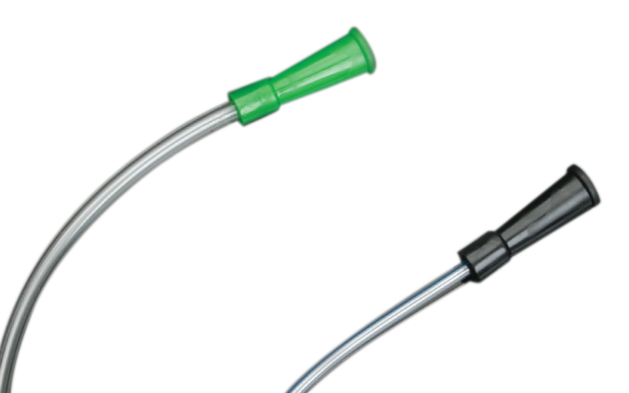
Duodenal Tube
Duodenal tubes are used in a variety of settings to drain gastric contents, decompress the stomach or duodenum, and to inject substances into or remove substances from the stomach.
| Ref. No.: | Size: | Qty.Cs: |
|---|---|---|
| NMD304295 | 16 Fr/Ch | 400 |
| NMD304296 | 18 Fr/Ch | 400 |
| NMD304297 | 20 Fr/Ch | 400 |
| NMD304298 | 22 Fr/Ch | 400 |
| NMD304299 | 24 Fr/Ch | 400 |
The duodenum is the first part of the small intestine and is about 25cm long. It starts at the pylorus (the opening from the stomach) and ends at the jejunum (the next part of the small intestine). The duodenum is where most chemical digestion takes place. The duodenum has a simple tube-like structure with a thin wall. The wall has three layers: an inner layer of mucous membrane, a middle layer of muscle tissue, and an outer layer of serosa (a type of protective tissue). The mucous membrane lining the duodenum contains numerous tiny finger-like projections called villi. These villi increase the surface area of the duodenum and help to absorb nutrients from food. The mucous membrane also contains cells that secrete digestive enzymes. The muscle tissue in the wall of the duodenum contract to move food through the intestine. This movement is called peristalsis. The serosa protects the duodenum and helps it to slide smoothly over other organs in the abdomen during peristalsis.
A duodenal tube is a thin, flexible tube that is inserted through the nose and down the throat into the stomach. The tube is then passed through the opening in the duodenum (the first part of the small intestine). The tube is used to withdraw stomach contents or to deliver nutrients directly to the small intestine. Inserting a duodenal tube requires general anesthesia. The doctor will insert a nasogastric (NG) tube through your nose and into your stomach. A guide wire is then passed through the NG tube and into your duodenum. The NG tube is then removed, leaving the guide wire in place. A duodenal feeding tube is then passed over the guide wire and into your duodenum. The feeding tube is connected to a bag of formula or other liquid nutrition. The formula or liquid nutrition is slowly infused into your small intestine through the feeding tube. After the infusion is complete, the feeding tube and guide wire are removed. You will be monitored for any complications during and after the procedure.
There are two types of duodenal tubes: endoscopic and surgical. Endoscopic duodenal tubes are inserted through the mouth and down the esophagus. A camera is attached to the end of the tube, which allows the doctor to see inside the stomach. This type of tube is used to measure the acidity of the stomach contents and to take biopsies (tissue samples). Surgical duodenal tubes are inserted through an incision in the abdomen. A camera is also attached to this type of tube, but it also has a light and suction device. This type of tube is used when there is a blockage in the intestine or if another surgery needs to be performed on the intestines.
A duodenal tube is a thin, flexible tube that is inserted through the nose and down the throat into the stomach. It is used to measure stomach acidity and to obtain a small sample of stomach contents for analysis. Duodenal tubes are usually inserted in people who have had surgery to remove part of their stomach or who have peptic ulcers. Duodenal tubes are also sometimes used to relieve symptoms of gastroparesis, a condition in which the stomach muscles are weak and food moves slowly through the digestive system. In these cases, the duodenal tube is used to bypass the sluggish stomach and deliver nutrients directly to the small intestine. There are several different types of duodenal tubes, including nasogastric, nasojejunal, and percutaneous endoscopic gastrostomy (PEG) tubes. Your doctor will determine which type of tube is best for you based on your individual medical needs.
A duodenal tube is a tube that is inserted through the nose and down the throat in order to reach the stomach. The tube goes through the jejunum, which is the second part of the small intestine, and enters directly into the stomach. A duodenal tube is usually used when there is a blockage in the stomach or when the person has difficulty swallowing.
A duodenal tube is a medical device that is inserted into the duodenum, the first section of the small intestine. The tube allows nutrients to be delivered directly to the small intestine, bypassing the stomach. The main advantage of a duodenal tube is that it can provide nutrition to people who cannot eat or who have difficulty absorbing nutrients from food. Duodenal tubes are often used for people who have had surgery on their stomach or intestines, or who have cancer or other conditions that make it difficult to eat or absorb nutrients. Another advantage of a duodenal tube is that it can be used to deliver medications directly to the small intestine. This can be helpful for people who need to take medication that may not be well tolerated if taken by mouth, or for people who have difficulty swallowing pills. There are also some disadvantages of duodenal tubes. One disadvantage is that they can cause side effects such as diarrhea, abdominal pain, and flatulence. Another disadvantage is that they can become infected if not properly cared for.